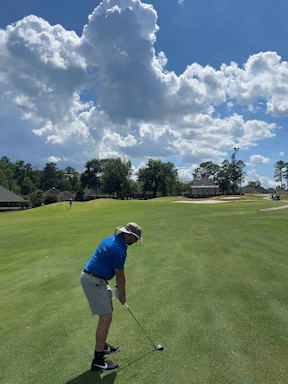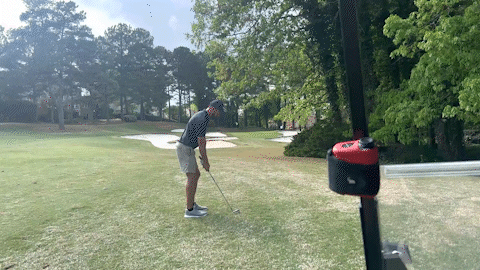
This page uses affiliate links. When you click an affiliate link, we get a small compensation at no cost to you. See Our Affiliate Policy for more info.
One of the more common questions amateur golfers ask involves increasing clubhead speed, and for a good reason. The faster one swings a golf club; the further the golf ball will go. However, that does not necessarily mean golfers should be hitting shots with 100% effort on every single shot. It is simply a matter of physics. This article will delve into golf swing speeds to help you understand how hard you should swing a golf club.

It is first important to note there is a difference between swinging a golf club harder and swinging a golf club faster. Swing a golf club harder does not necessarily mean it will be faster, and in most cases, the opposite is true where the clubhead speed is lower. This is due to more tension in the golf swing, which leads to more unnatural movements to get the golf club to the ball as fast as possible.
With that being said, it is better to swing faster in golf and not harder, as generally speaking, the lower the handicap one has, the higher the clubhead speed will be. Learn how to calculate golf handicaps here. While some may disagree, the fact of the matter is that distance plays an important role in how good one can be as a golfer. Hitting a driver 250 yards instead of 200 yards can have a significant impact on your approach shots and getting that GIR in golf.
To swing faster and not harder, golfers must focus on overall balance, shoulder rotation on the backswing, and hip rotation on the downswing. Which leads us to ask the question: Are golf shoes worth it?
First and foremost, a golfer should have a solid foundation and maintain good balance throughout the golf swing, not “swinging out their shoes,” so to speak. If you watch a PGA Tour event, you will notice that all top golfers have great balance throughout their swings and can hit the golf ball with over 110 mph clubhead speed and it looks effortlessly. Part of this has to do with shoulder rotation on the backswing.
As one brings the clubhead back, their shoulders should rotate away from the target while keeping the head as still as possible. The downswing also requires rotation involving the hips.
At the top of the backswing and beginning the downswing, golfers should look to clear their hips towards the target. Doing so will drag the clubhead downward and around, thus generating more speed.
Except for a handful of players such as Hideki Matsuyama and Jim Furyk, most PGA Tour players have a fairly quick backswing and follow-through. It helps them to be more relaxed and not overthink what they are doing, in that they simply rely on muscle memory instead and thus can maintain flexibility in their golf swings for increased distance.
There are three areas to pay attention to, which can indicate a good indication of swinging the golf club too hard. The first and most obvious one is tension, in that more added tension will be throughout the golf swing.
The second is that golfers will feel they are rushing to complete the golf swing from start to finish without fully going through the required motions (rotating shoulders and hips). The opposite can also happen occasionally, where golfers overthink things and try to wind up with a slower backswing and a faster follow-through.
The only exception may be when you are hitting out of the rough. Learn how to hit out of the rough here!
Lastly, right-handed golfers will notice the golf ball slicing more than usual, with the opposite happening to left-handed players. This happens because the golf club attempts to pull down after completing the backswing, which causes the club to go more towards the inside of the swing path, causing the slice.
Can swinging the golf club slower lead to success out on the golf course? There are many different ways to tackle a golf course, and using slower swing speeds could certainly work. If one has practiced using slower swing speeds, it can lead to both greater accuracy and control, raising your FIR in golf statistic. It is an option worth considering if one is struggling with finding the fairways and greens.

Swinging slower will lead to a drastic decrease in distance. Also, the swing used to generate a lot of clubhead speed will likely not work to swing the club slower deliberately. So, in other words, unless a golfer has been practicing shots using a slower swing speed, they cannot simply flip a switch and automatically change their swing speed without negative ramifications. The most common problem is that the swing path will change, leading to more shots that are mishit. Golfers must readjust when they rotate their shoulders and hips in the golf swing to accommodate for the change in swing speed, which can take some time to learn. Golfers that break 80 consistently find the correct swing plane to speed ratio. Find out what percentage of golfers break 80 here.
Without getting into all of the technical details, golfers should try to swing as fast as possible while maintaining balance. Generally speaking, around 20 percent of the club head speed comes from rotating your body, and the remaining 80 comes from the arms and hands. Learn how to maintain your clubhead speed as you get older here.
Ensuring you are rotating the shoulders and hips correctly can help maximize swing speed while maintaining balance. Completing the backswing is another important consideration, as many amateur golfers want to pivot downwards quickly and only get three-quarters of the way back. Completing the backswing and rotating the hips as the golf club goes on its downward trajectory will help golfers reach the highest swing speed possible.